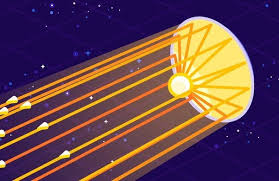In the far future when humanity has mastered the Dyson’s Sphere and nuclear fusion and we are planning not years or decades but eons in advance, we may encounter a threat like a exploding super giant, or a growing black hole. When something like this happens humanity is doomed right? No, because of this amazing thing called a stellar engine. Powered by the sun through a Dysons swarm, it can push the entire solar system.
There are three defined classes of stellar engine, ranging from a glorified mirror, to a massive rocket engine powered by nuclear fusion. The first type is called a Shkadov Thruster, a gigantic mirror the reflects photons from the sun to use propulsion. It can only be used at the sun’s poles for the fear of roasting a planet to a crisp. The next type of stellar engine is a “Class B engine” which consists of two concentric circles. Unlike the other types this engine provides no thrust, only electricity. The inner circle heats up and the temperature difference would drive massive engines that would provide electricity.
The third type off stellar engine is creatively named a “Class C” Engine takes the Shkadov and the Class B and puts them together to create a sort of ring mirror thing that pushes the sun using it’s photons. The next and arguably most realistic one is the Caplan Thruster; a massive fusion powered sun fueled rocket booster. By using lasers formed by a dysons torus to excite a small area of the sun, it would cause coronal ejections made up of billions of tons of helium and hydrogen to shoot out. Then the rocket uses massive magnetic fields to draw the ejected mass into a fusion reactor where the helium is explosively burnt into a thermonuclear pile of radioactive oxygen, which is then shot out the back at nearly a billion degrees. It doesn’t matter whether its Fahrenheit or Celsius, its still burning at an insane temperatures. The hydrogen on the other hand is shot out of the front using extremely efficient particle accelerators back at the sun in order to push it.

Related Articles:
https://www.sciencedirect.com/science/article/abs/pii/S0094576519312457
https://ui.adsabs.harvard.edu/abs/2000JBIS…53..297B/abstract
https://sites.google.com/view/m-caplan-stellar-engines/startseite
https://imagine.gsfc.nasa.gov/features/cosmic/milkyway_info.html
https://www.dynamical-systems.org/zwicky/stellarengines.pdf
Take Action
I don’t know how you would make a stellar engine so there are no “take action” links. Sorry.



